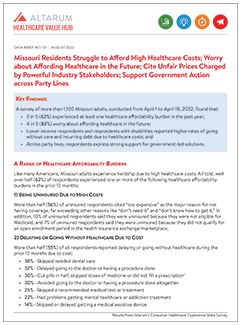Missouri Residents Struggle to Afford High Healthcare Costs; Worry about Affording Healthcare in the Future; Cite Unfair Prices Charged by Powerful Industry Stakeholders; Support Government Action across Party Lines
Key Findings
A survey of more than 1,100 Missouri adults, conducted from April 1 to April 18, 2022, found that:
- 3 in 5 (62%) experienced at least one healthcare affordability burden in the past year;
- 4 in 5 (82%) worry about affording healthcare in the future;
- Lower-income respondents and respondents with disabilities reported higher rates of going without care and incurring debt due to healthcare costs; and
Across party lines, respondents express strong support for government-led solutions.
A Range of Healthcare Affordability Burdens
Like many Americans, Missouri adults experience hardship due to high healthcare costs. All told, well over half (62%) of respondents experienced one or more of the following healthcare affordability burdens in the prior 12 months:
1) Being Uninsured Due to High Costs
More than half (56%) of uninsured respondents cited “too expensive” as the major reason for not having coverage, far exceeding other reasons like “don’t need it” and “don’t know how to get it.” In addition, 10% of uninsured respondents said they were uninsured because they were not eligible for Medicaid, and 7% of uninsured respondents said they were uninsured because they did not qualify for an open enrollment period in the health insurance exchange/marketplace.
2) Delaying or Going Without Healthcare Due to Cost
More than half (55%) of all respondents reported delaying or going without healthcare during the prior 12 months due to cost:
- 36%—Skipped needed dental care
- 32%—Delayed going to the doctor or having a procedure done
- 30%—Cut pills in half, skipped doses of medicine or did not fill a prescription1
- 30%—Avoided going to the doctor or having a procedure done altogether
- 25%—Skipped a recommended medical test or treatment
- 22%—Had problems getting mental healthcare or addiction treatment
- 14%—Skipped or delayed getting a medical assistive device
Moreover, cost was the most frequently cited reason for not getting needed medical care (reported by 26% of respondents), exceeding a host of other barriers like difficulty getting an appointment, transportation and lack of childcare.
3) Strugging to Pay Healthcare Bills
Other times, respondents got the care they needed but struggled to pay the resulting bill. More than 2 in 5 (42%) experienced one or more of these struggles to pay their medical bills:
- 22%—Were contacted by a collection agency
- 14%—Used up all or most of their savings
- 12%—Were unable to pay for basic necessities like food, heat or housing
- 10%—Borrowed money, got a loan or another mortgage on their home
- 9%—Racked up large amounts of credit card debt
- 7%—Were placed on a long-term payment plan
Of the various types of medical bills, the ones most frequently associated with an affordability barrier were doctor bills, dental bills and prescription drugs. The high prevalence of affordability burdens for these services likely reflects the frequency with which Missouri respondents seek these services. Trouble paying for dental bills likely reflects lower rates of coverage for these services.
High Levels of Worry About Affording Healthcare in the Future
Missouri respondents also exhibit high levels of worry about affording healthcare in the future. Four in five (82%) reported being “worried” or “very worried” about affording some aspect of healthcare in the future, including:
- 66%—Cost of nursing home or home care services
- 63%—Medical costs when elderly
- 60%—Health insurance will become unaffordable
- 60%—Medical costs in the event of a serious illness or accident
- 55%—Cost of dental care
- 52%—Prescription drugs will become unaffordable
- 36%—Cost of treatment for coronavirus/COVID-19
While two of the most common worries—affording the cost of nursing home or home care services and medical costs when elderly—are applicable predominantly to an older population, they were most frequently reported by respondents ages 35-54 (as well as respondents ages 18-35 regarding worry about affording care when they are elderly). This finding suggests that Missouri respondents may be worried about affording the cost of care for both aging parents and themselves.
Worry about affording healthcare, generally, was highest among respondents living in low- and middle-income households, respondents of color and those living in households with a person with a disability (see Table 1). More than 4 in 5 (88%) of respondents with household incomes of less than $50,000 per year2 reported worrying about affording some aspect of coverage or care in the past year. Still, the vast majority of Missouri respondents of all incomes, races, ethnicities and levels of ability statewide are somewhat or very concerned.
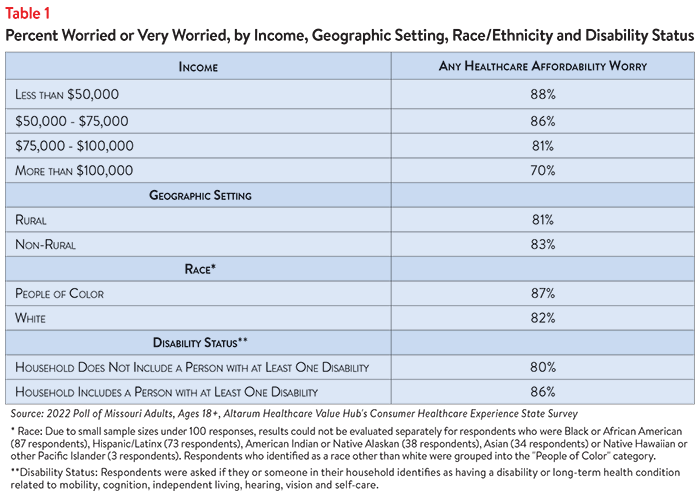
Concern that health insurance will become unaffordable is also more prevalent among certain groups of Missouri adults. By insurance type, respondents with coverage through MO HealthNet most frequently reported worrying about both losing and affording coverage, followed by respondents who buy their insurance on their own and those with employer-sponsored insurance (see Figure 1).

Those with household incomes below $50,000 per year reported the highest rates of worry about both losing AND affording coverage compared to higher-income respondents, while non-rural respondents and those living in households with a person with a disability reported higher rates of being concerned about losing health insurance specifically than those living in rural areas and those not living with a person with a disability (see Table 2).
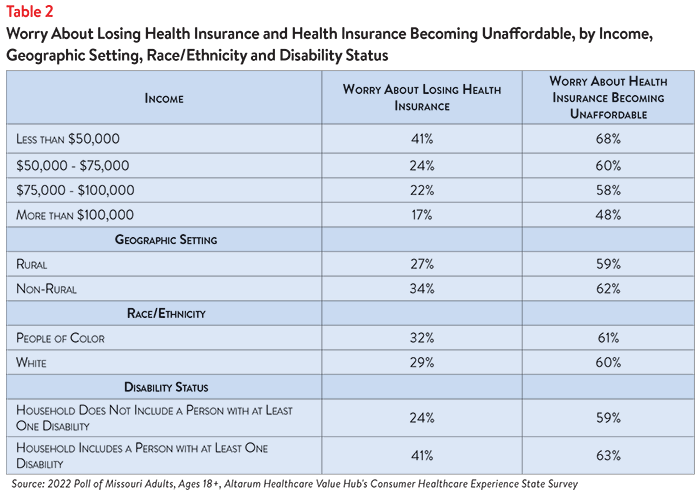
Concerns about affording coverage exceeded fears about losing coverage across all income groups, disability statuses, geographic settings and coverage types.
Differences in Healthcare Affordability Burdens
The survey also revealed differences in how Missouri respondents experience healthcare affordability burdens by income, age, geographic setting and disability status.
Income and Age
Unsurprisingly, respondents at the lowest end of the income spectrum most frequently reported experiencing one or more healthcare affordability burdens, with nearly three-quarters (74%) of those earning less than $50,000 reporting struggling to afford some aspect of coverage or care in the past 12 months (see Figure 2). This is, in part, due to respondents in this income group reporting the highest rates of going without care and rationing their medication due to cost (see Figure 3).
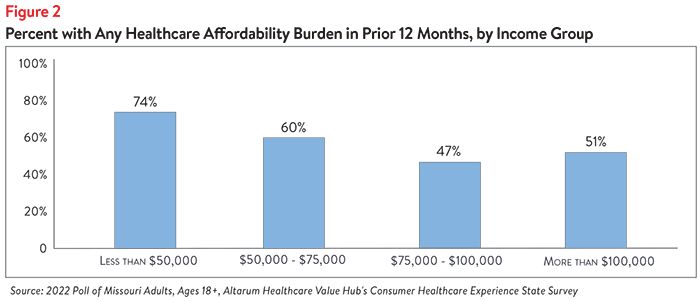
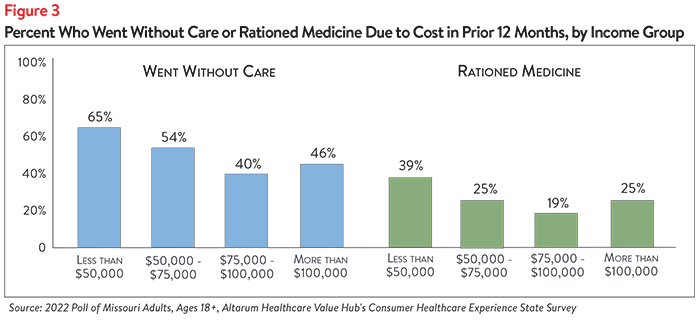
Further analysis found that Missouri respondents ages 18-44 reported higher rates of going without care due to cost than respondents ages 45 and up (see Figure 4). Respondents ages 25-34 most frequently rationed medication due to cost, compared to other groups.
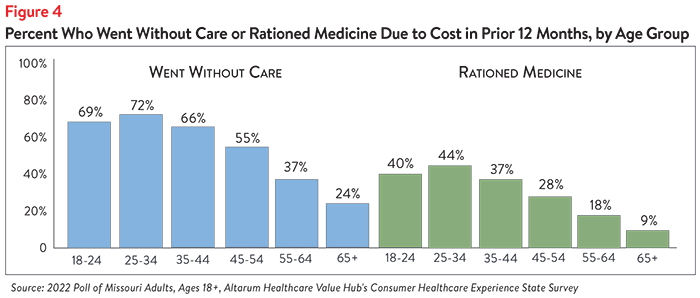
Insurance Type
Uninsured respondents reported the highest rates of going without care due to cost AND the highest rates of rationing medication by a large margin compared to other insurance types, followed by those with MO HealthNet (see Table 3). Still, nearly 3 in 5 respondents with employer-sponsored insurance or insurance they purchased on their own went without care due to cost.

Race
Respondents of color reported higher rates of going without care and rationing medication due to cost when compared to white respondents (see Table 3). Further analysis showed that respondents of color had slightly higher rates of problems getting mental health care, problems getting addiction treatment, and skipping needed dental care (see Figure 5).
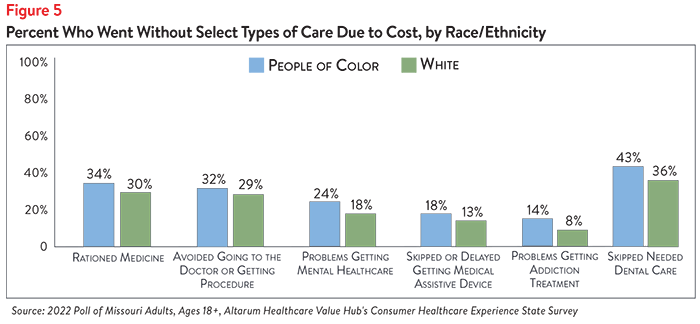
Disability Status
Of all the demographic groups measured, respondents living in households with a person with a disability reported the highest rates of going without care and rationing medication due to cost in the past 12 months. More than 7 in 10 (73%) of respondents in this group went without some form of care and almost half (45%) rationed medication, compared to 47% and 23% of respondents living in households without a person with a disability, respectively (see Table 3). Respondents living in households with a person with a disability also more frequently reported delaying or skipping getting mental healthcare, addiction treatment and dental care, among other health care services, than those in households without a person with a disability due to cost concerns (see Table 4).
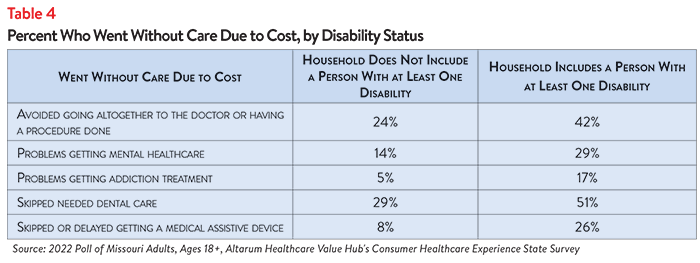
Those with disabilities also face healthcare affordability burdens unique to their disabilities—26% of respondents reporting a disability in their household delayed getting a medical assistive device such as a wheelchair, cane/walker, hearing aid or prosthetic limb due to cost. Just 8% of respondents without a person with a disability (who may have needed such tools temporarily or may not identify as having a disability) reported having this experience.
Likelihood of Encountering Medical Debt
The survey also showed differences in the prevalence of financial burdens due to medical bills, including going into medical debt, depleting savings and being unable to pay for basic necessities (like food, heat and housing) by income, race, disability status and geographic setting. Forty-five percent of respondents of color reported going into debt, depleting savings or going without other needs due to medical bills, compared to 41% of white respondents (see Table 5).
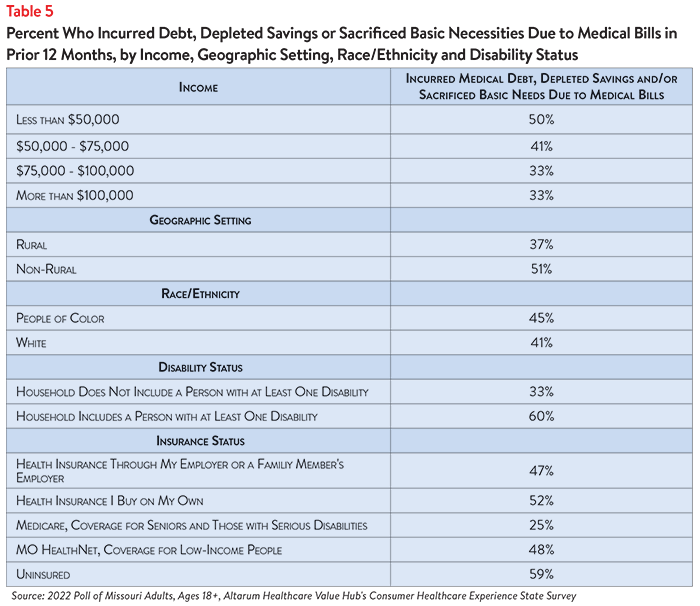
Respondents living in households with a person with a disability had an even greater disparity, with more than half (57%) reporting going into debt or going without other needs due to medical bills, compared to 1 in 4 (26%) of respondents living in households without a disabled member. Geographically, Missouri respondents living in non-rural counties reported higher rates of going into debt or going without other needs due to medical bills (51%) than respondents from rural counties (37%). In addition, uninsured respondents reported the highest rate of the above financial burdens due to medical bills (59%) compared to all other insurance types, followed by those who purchased insurance on their own (52%).
Healthcare affordability burdens often occur alongside systemic mistreatment in the health system, making it even more difficult for marginalized communities to access care. For further details, see: Equity Issues in Missouri Healthcare Affordability and Mistreatment in the Health System.
Dissatisfaction with the Health System and Support for Change
In light of Missouri respondents healthcare affordability burdens and concerns, it is not surprising that they are dissatisfied with the health system:
- Just 33% agreed or strongly agreed that “we have a great healthcare system in the U.S.,”
- While 71% agreed or strongly agreed that “the system needs to change.”
To investigate further, the survey asked about both personal and governmental actions to address health system problems.
Personal Actions
Missouri respondents see a role for themselves in addressing healthcare affordability. When asked about specific actions they could take:
- 59% of respondents reported researching the cost of a drug beforehand, and
- 81% said they would be willing to switch from a brand name to an equivalent generic drug if given the chance.
When asked to select the top three personal actions they felt would be most effective in addressing healthcare affordability (out of ten options), the most common responses were:
- 67%—Take better care of my personal health
- 37%—Research treatments myself, before going to the doctor
- 29%—There is not anything I can do personally to make our health system better
- 28%—Do more to compare doctors on cost and quality before getting services
Government Actions
Missouri respondents see government as the key stakeholder that needs to act to address health system problems. Moreover, addressing healthcare problems is a top priority that respondents want their elected officials to work on.
At the beginning of the survey, respondents were asked what issues the government should address in the upcoming year. The top responses were:
- 53%—Healthcare
- 48%—Economy/Joblessness
- 38%—Taxes
When asked about the top three healthcare priorities the government should work on, the top responses were:
- 52%—Address high healthcare costs, including prescription drugs
- 37%—Get health insurance to those who cannot afford coverage3
- 36%—Preserve consumer protections preventing people from being denied coverage or charged more for having a pre-existing medical condition
- 34%—Improve Medicare, coverage for seniors and those with serious disabilities
Of more than 20 options, Missouri respondents believe the reason for high healthcare costs is unfair prices charged by powerful industry stakeholders:
- 75%—Drug companies charging too much money
- 72%—Hospitals charging too much money
- 66%—Insurance companies charging too much money
When it comes to tackling costs, respondents endorsed a number of strategies, including:
- 94%—Make it easy to switch insurers if a health plan drops your doctor
- 94%—Show what a fair price would be for specific procedures
- 93%—Ensure the cost of widely needed vaccines are affordable for all
- 92%—Authorize the Attorney General to take legal action to prevent price gouging or unfair prescription drug price hikes
- 92%—Require insurers to provide up-front cost estimates to consumers
- 92%—Require hospitals and doctors to provide up-front cost estimates to consumers
Support For Action Across Party Lines
There is also remarkable support for change regardless of respondents’ political affiliation (see Table 6).
The high burden of healthcare affordability, along with high levels of support for change, suggest that elected leaders and other stakeholders should make addressing this consumer burden a top priority. Moreover, the current COVID crisis has led state residents to take a hard look at how well health and public health systems are working for them, with strong support for a wide variety of actions. Annual surveys can help assess whether progress is being made.
Notes
1. Of the current 55% of Missouri respondents who encountered one or more cost-related barriers to getting healthcare during the prior 12 months, 24% did not fill a prescription, while 21% cut pills in half or skipped doses of medicine due to cost.
2. Median household income in Missouri was $57,290 (2016-2020). U.S. Census, Quick Facts. Retrieved from: https://www.census.gov/quickfacts/MO
3. Nearly 2 in 3 (63%) of respondents said that they would consider using their tax forms to sign up for health insurance if they or their family needed it. This high level of interest persisted across racial, ethnic and income groups, with the highest levels of interest among respondents of color (62%) and those earning between $50,000 and $75,000 (68%).




